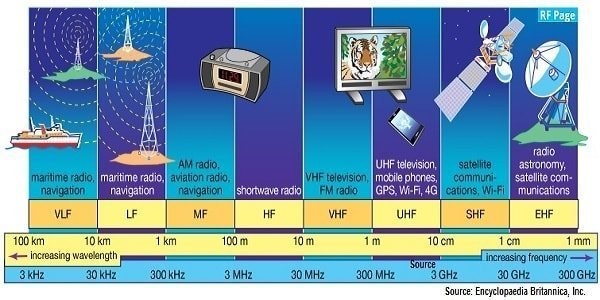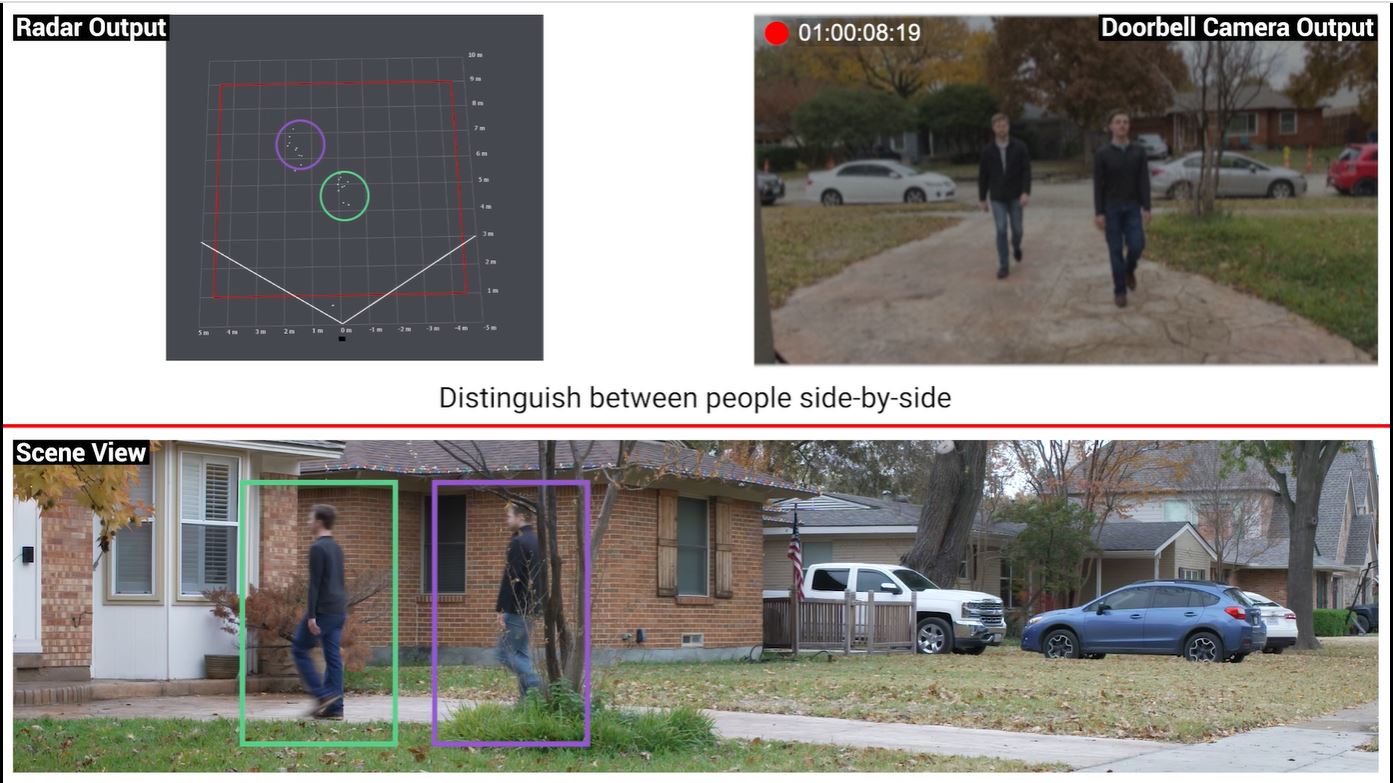SWRA766 January 2023 IWRL6432 , IWRL6432AOP
The goal of this applications brief is to inform and educate partners and customers on the advancements that Texas Instruments’ has made in millimeter wave (mmWave) Radar sensing. The key advancement discussed in this brief is the release of the IWRL6432 low power 60 GHz mmWave radar sensor that can run sensing applications from a typical battery.
The Technology: What is mmWave Radar Sensing?
mmWave is a radio frequency (RF) sensing technology that works in the spectrum band between 30 GHz and 300 GHz. mmWave has a wavelength of 1 millimeter up to 10 millimeters. Therefore, the industry term most often used for the technology is mmWave as a result of the aforementioned wavelength. The sensing technology works by using one or more RF transmitters to send short radio pulses at pre-determined frequencies from an on-chip frequency generator into an area. The radio pulses reflect off objects in the area, and those reflections are captured on the same integrated circuit (IC) by one or more on-chip RF receivers. Information about the reflected signal is then used to determine range, velocity and angle of reflection of a person/object with an unmatched level of accuracy and reliability. The range is the distance of the object from the sensor. While the velocity is the speed and direction of movement of the object. Finally, the angle of reflection is the angle at which the reflected signals return to the sensor upon reflection. This information is used to determine the precise location of the object relative to the sensor and in a three-dimensional space.
As previously mentioned, mmWave is an RF technology. Therefore, mmWave sensors are only mildly susceptible to changes in or less than ideal environmental conditions. Conditions such as bright sunlight, darkness, rain, sleet, snow, smoke, fog, high humidity, extreme high or extreme low temperatures have little to no impact on the accuracy of a mmWave radar sensor. As a result, radar can be used in all kinds of applications, whether industrial, residential, indoors or outdoors, where competing technologies fail.
mmWave radar sensors detect people and protect their identities. As an RF based sensing technology the sensors do not return any visual nor identifying information unique to a specific person or object. You don't get a visual of the object or person. The radar does not return any information that can compromise someone's privacy beyond presence and number of objects detected. Additionally, the radar can be easily installed behind objects allowing the radar to run invisibly, reliably and robustly. The radar can sense through various media (e.g. glass, plastic, wood, drywall of varying thickness and more). Therefore, the radar can be placed behind a picture or behind curtains, basically out of plain sight.
 Figure 1-1 US Frequency Spectrum
Figure 1-1 US Frequency SpectrumIWRL6432: Low Power Use Cases/Products
To date, mmWave Radar sensing based products for industrial use have been largely relegated to line-powered applications. This limited radar’s potential use-cases and product appeal despite the performance advantages that the technology has over competing technologies like Passive Infrared (PIR) sensors. IWRL6432, with focus on high-performance while consuming less power is set to change that.
Radar can supplement the camera in products like home security cameras and video doorbells, adding functionality such as precise location detection, low-power presence detection, human vs non-human classification and person counting, while reducing false detections/alarms. End equipment developers can even decide to replace the camera completely to allow the security solution to be placed in areas where personal privacy is of concern and non-visual observation is desired like bedrooms and restrooms. The low-power consumption of the device enables battery power too, further increasing the areas where the device can be placed. Table 1-1 give some use cases of battery powered radars.
| Function | Performance | Avg Power Consumption | End Equipment |
|---|---|---|---|
| Presence Detection | 7 meters (localization) | 2mW | Lighting Control, Indoor Occupancy Sensors, Thermostats, Appliances |
| Motion Detection | 15 meters | 10mW | Video Doorbell, Home Surveillance |
| Tracking and Classification | 3+ person tracking | 50mW | Doors/Gates, Surveillance with classification |
Indoor Occupancy Sensors and Radar Enabled Lights & Fixtures can now be battery powered, making installation possible nearly anywhere. Using the radar, these products count and localize the number of people in a room. Lighting and ventilation systems, which previously only knew whether people were present/not-present, become more efficient and robust. Minor motion detection enabled by mmWave radar sensor is a key feature in improving the efficiency of these products. Using the IWRL6432, motion is detected from the slightest movements such as typing or breathing enabling more precise monitoring of offices, hotel rooms etc.
Personal Electronics like laptops, earbuds, music players and the like can also be outfitted with the IWRL6432 due to low power consumption. For example, laptops can now use radar for “on-looker” presence detection to dim the display when there is an unwanted presence within a specified area around the user and not compromise the battery life of the laptop.
Many new applications of radar can be realized with the low power consumption, accurate and reliable range, velocity and location information that the IWRL6432 provides.
 Figure 1-2 IWRL6432 Video Doorbell Demonstration with Camera and Radar Shown
Figure 1-2 IWRL6432 Video Doorbell Demonstration with Camera and Radar ShownThe Design: What Makes the Power so Low?
The IWRL6432 is developed in Texas Instruments low power 45nm RFCMOS process to enable unprecedented levels of integration and power consumption. This radar sensor deploys a mix of hardware design and software techniques to minimize the power consumption while in active and sleep modes. The radar IC is partitioned into four (4) power domains (see Figure B below) which can be turned on/off via software controls.
- RF / Analog Subsystem – includes all RF and analog components required to transmit and receive RF signals
- Front-end Controller Sub-system: includes the processor responsible for radar front-end configuration, control and calibration
- Application Sub-system: includes the ARM Cortex®-M4, clocking and power managements sub-blocks
- Hardware Accelerator Sub-system: includes the FFT and Constant False Alarm Rate (CFAR) accelerators for scaling and compression
The device also features the capability to exercise various low-power states like sleep and deep sleep. Low-power sleep mode is achieved by clock gating and by turning off specified internal blocks of the device. The power states and their associated description are listed in Table 1-2 below and include Active, Processing, Idle and Deep Sleep States. In an effort to maximize performance and minimize power consumption the device can go in/out of the various modes extremely quickly. IWRL6432 also includes features such as memory retention while in low power states to retain some contents of the on-chip memory like the RF chirp profile and the application image. Texas Instruments provides detailed documentation and examples on how to navigate the IWRL6432 through the device's multiple power modes and states. Take a look at the device data sheet and other design materials in the IWRL6432 product folder to get more detailed information.
| Mode | Description |
|---|---|
| Active | RF activity is present |
| Processing | Data is being processed and the RF / Analog Sub-system is turned off |
| Idle | State occurs during inter-frame/inter-burst/inter-chirp idle time |
| Deep Sleep | Lowest possible power state of the device where the contents of the device can be retained and the device need not boot from scratch |
Conclusion
As buildings, homes, factories and personal electronics get smarter the bar is raised on the sensing requirements and modalities while keeping power consumption to a minimum. The IWRL6432 meets the bar in enabling robust, reliable, accurate high-performance sensing solutions with limited power consumption. To learn more, visit www.ti.com/product/IWRL6432